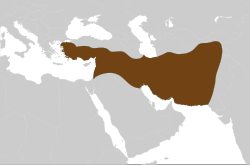Seleukid
| Seleucid Empire | ||||||||||||||||||
| Βασιλεία τῶν Σελευκιδῶν | ||||||||||||||||||
|
||||||||||||||||||
|
Tetradrachm of Seleucus I, the horned horse, the elephant and the anchor were all used as symbols of the Seleucid monarchy.
|
||||||||||||||||||
|
The empire at its greatest extent and on the eve of the death of Seleucus I, 281 BC
|
||||||||||||||||||
| Capital | ||||||||||||||||||
| Languages | ||||||||||||||||||
| Religion | ||||||||||||||||||
| Government | Monarchy | |||||||||||||||||
| Basileus | ||||||||||||||||||
| • | 305–281 BC | Seleucus I (first) | ||||||||||||||||
| • | 65–63 BC | Philip II (last) | ||||||||||||||||
| Historical era | Hellenistic period | |||||||||||||||||
| • | Wars of the Diadochi | 312 BC | ||||||||||||||||
| • | Battle of Ipsus | 301 BC | ||||||||||||||||
| • | Roman–Seleucid War | 192–188 BC | ||||||||||||||||
| • | Treaty of Apamea | 188 BC | ||||||||||||||||
| • | Maccabean Revolt | 167–160 BC | ||||||||||||||||
| • | Annexed by Rome | 63 BC | ||||||||||||||||
| Area | ||||||||||||||||||
| • | 303 BC | 3,000,000 km2 (1,200,000 sq mi) | ||||||||||||||||
| • | 301 BC | 3,900,000 km2 (1,500,000 sq mi) | ||||||||||||||||
| • | 270 BC | 3,200,000 km2 (1,200,000 sq mi) | ||||||||||||||||
| • | 240 BC | 2,600,000 km2 (1,000,000 sq mi) | ||||||||||||||||
| • | 175 BC | 800,000 km2 (310,000 sq mi) | ||||||||||||||||
|
||||||||||||||||||
The Seleucid Empire (/sɪˈljuːsɪd/;Ancient Greek: Βασιλεία τῶν Σελευκιδῶν, Basileía tōn Seleukidōn) was a Hellenistic state ruled by the Seleucid dynasty, which existed from 312 BC to 63 BC; it was founded by Seleucus I Nicator following the division of the Macedonian empire vastly expanded by Alexander the Great. Seleucus received Babylonia and, from there, expanded his dominions to include much of Alexander's near eastern territories. At the height of its power, it included central Anatolia, Persia, the Levant, Mesopotamia, and what is now Kuwait, Afghanistan, and parts of Pakistan and Turkmenistan.
The Seleucid Empire was a major center of Hellenistic culture that maintained the preeminence of Greek customs where a Greek political elite dominated, mostly in the urban areas. The Greek population of the cities who formed the dominant elite were reinforced by immigration from Greece. Seleucid expansion into Anatolia and Greece was abruptly halted after decisive defeats at the hands of the Roman army. Their attempts to defeat their old enemy Ptolemaic Egypt were frustrated by Roman demands. Having come into conflict with Chandragupta Maurya of the Maurya Empire, after several defeats, Seleucus entered into an agreement with Maurya where he ceded vast territory west of the Indus, including the Hindu Kush, modern day Afghanistan, and the Balochistan province of Pakistan and offered his daughter for marriage to the Emperor to formalize the alliance. Much of the eastern part of the empire was conquered by the Parthians under Mithridates I of Parthia in the mid-2nd century BC, yet the Seleucid kings continued to rule a rump state from Syria until the invasion by Armenian king Tigranes the Great and their ultimate overthrow by the Roman general Pompey.
...
Wikipedia

![Tetradrachm of Seleucus I, the horned horse, the elephant and the anchor were all used as symbols of the Seleucid monarchy.[1][2]](http://upload.wikimedia.org/wikipedia/commons/thumb/c/c8/201209071746a_Berlin_Pergamonmuseum%2C_Tetradrachme_Seleukos%27_I%2C_Silber%2C_Pergamon%2C_281-280_v.u.Z.jpg/170px-201209071746a_Berlin_Pergamonmuseum%2C_Tetradrachme_Seleukos%27_I%2C_Silber%2C_Pergamon%2C_281-280_v.u.Z.jpg)
